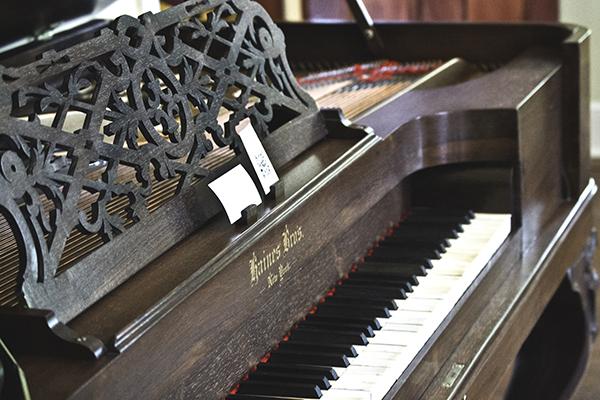A new exhibit in Gorgas House will feature original Civil War artifacts belonging to the Gorgas family, including the coat and ceremonial sword of General Josiah Gorgas.
The exhibit, “North and South: the Gorgas Family, The University of Alabama, and the Divisions of the Civil War,” is now open in the Gorgas House Museum.
General Josiah Gorgas was the Chief of Ordnance for the Confederate Army during the Civil War. In 1853, Gorgas married Amelia Gayle, daughter of former Alabama Governor John Gayle. The two had six children.
Gorgas chose to serve the Confederate state of Alabama despite his Pennsylvanian nativity. Because of his position in the Confederacy, the end of the war brought an end to Gorgas’ military career.
The exhibit will display information on the wartime experiences of the Gorgas family, research gathered by University of Alabama students and artifacts recently unearthed by the Office of Archaeological Research staff from the University’s original 1831 campus. Outlining the sacrifices and hardships of a young man and his family during the Civil War, the exhibit will explore the experiences of Josiah Gorgas and his family as they were separated during wartime.
“As the war went along everyday life became chaotic and desperate,” said John Giggie, a professor in the UA history department and author of “After Redemption: Jim Crow and the Transformation of African American Religion in the Delta.”
“Most men above the age of sixteen were directly involved in war efforts, food became scarce and there were outbreaks of local violence,” Giggie said. “Many slaves at that time were more openly aggressive when demonstrating their anger towards being a slave. They were running away, refusing to do work and threatening former masters and mistresses. It was a world like none other American experienced, especially Alabamians.”
In 1860, the functionality of the University shifted when the University converted to a military school for the Confederacy.
“It was an amazingly fertile source for the recruitment and production of Confederate soldiers,” Giggie said.
The University exclusively enrolled white, male students. According to Giggie, many of the enrolled students at the University during this time would attend university affairs accompanied by a slave.
Approximately seven generals, 25 colonels, 14 lieutenant colonels, 21 majors, 125 captains, 273 staff and other commissioned officers and 294 private soldiers were trained and recruited at the University during the war, providing the Confederate Army with an estimated 30 military units.
Unlike many Confederate states, such as Georgia, Mississippi and Tennessee, no major Civil War battles were fought on Alabama soil. Tuscaloosa itself was far removed from any major military port or theater of the war. Giggie said, it was a “miracle” Tuscaloosa experienced the repercussions of the war that it did.
“Federal troops targeted the University because Confederate troops and militia had been trained on campus,” George Rable, professor in the department of history, said.
Specializing in Southern history, Rable is the author of a number of publications including, “Fredricksburg! Fredricksburg!” and “God’s Almost Chosen Peoples: A Religious History of the American Civil War.”
“Since the University produced hundreds of Confederate military officers, burning almost the entire campus was a way to demonstrate the power of the Union army,” Giggie said. “At this point, the Union was just extending their reach and tightening their grip on Confederate outposts.”
With the behest to destroy the bridge, factories, mills, university, and whatever else may be of benefit to the rebel cause, General John T. Croxton and his federal cavalry of 1,500 Union soldiers began the march to Tuscaloosa in late March 1865.
At dusk on April 3, 1865, only days before Robert E. Lee surrendered to Ulysses S. Grant at the Appomattox Courthouse on April 9, Croxton and his federal cavalry pillaged through Northport en route to the University.
“Cadets from campus marched down University Boulevard to confront federal cavalry that had crossed the river from Northport, but they were badly outnumbered and outgunned and were soon withdrawn,” Rable said. “The federal forces then proceeded to burning the campus.”
Craxton’s cavalry of equipped Union soldiers, overpowering the defending University cadets, invaded Tuscaloosa. On the morning of April 4, the cavalry began the fire that would destroy several campus buildings, including dormitories and the library. The Gorgas House, the little guardhouse, the observatory and the president’s mansion were the only to survive.
In 1867, the University began reconstruction and opened to students in 1871. In 1883, Josiah Gorgas became the eighth president of The University of Alabama. After suffering a stroke a year later, Gorgas resigned as president and assumed the role of librarian until his death in 1888.
“The rebuilding of campus mirrored the pace of the South after the Civil War in that it was a slow and difficult process,” Giggie said. “Raising money, securing supplies, even winning back students to pay tuition was difficult after the war because for many people, the first order of business was just to reunite with their family and take care of wounded relatives. Many had to rebuild their lives, literally.”
“North and South: the Gorgas Family, The University of Alabama, and the Divisions of the Civil War” will be on display in the Gorgas House Museum through Oct. 23. The museum is open 9:00 a.m. to noon and 1 to 4:30 p.m. weekdays. General admission is $2.









